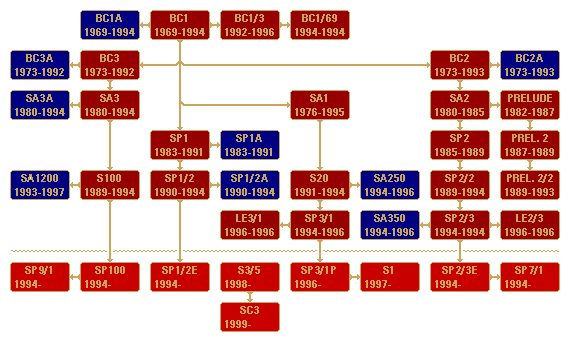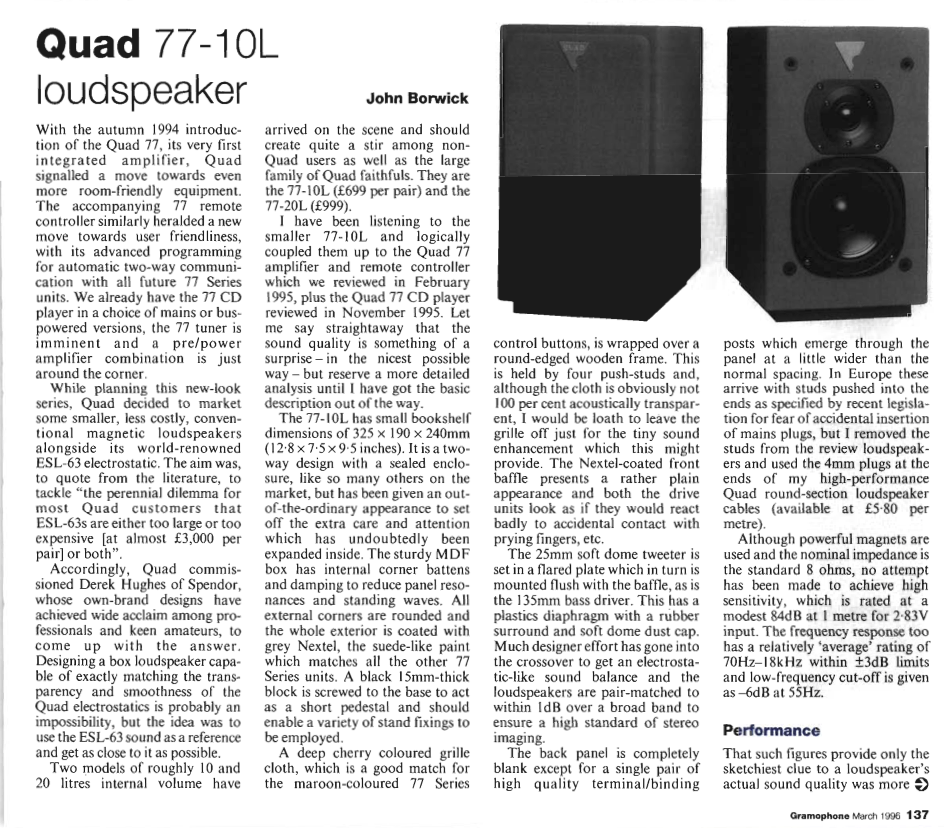The BBC had it's own research team of engineers, dedicated facilities and specific design objectives.
A small selection of old papers by the BBC Research Department.
A Survey of Performance Criteria and Design Considerations for High-Quality Monitoring Loudspeakers
D.E.L. Shorter - January 1959
Loudspeakers used for monitoring purposes in broadcasting and recording studios are designed to give the nearest practicable approach to realistic reproduction. The paper discusses the various criteria which can be applied to the performance of such loudspeakers, together with the relationship between the measured free-field characteristics and the response as subjectively assessed in the working environment. While the degree of realism achieved in sound reproduction can only be judged aurally, even subjective assessments can be misleading unless carried out under controlled conditions and with clearly defined terms of reference; the precautions necessary in such tests are discussed. Some of the less obvious design considerations are reviewed and illustrated by examples.
http://www.aes.org/e-lib/browse.cfm?elib=579 ($)
Design of a new free-field sound measurement room: Specification and performance
D.E.L. Shorter, H.D. Harwood (Harbeth), C.L.S. Gilford, J.R. Chew, R.L. Deane - 1965
The various requirements laid down in the design of the new free-field room at Kingswood Warren are discussed. Details are given of the building, the acoustic treatment and the associated technical equipment. Acoustic tests on the completed room are described; the frequency range over which free-field conditions can be obtained depends to some degree on the direction of sound propagation, but in favourable circumstances extends to below 50 c/s.
http://downloads.bbc.co.uk/rd/pubs/reports/1965-17.pdf
The design of a low-frequency unit for monitoring loudspeakers
H.D. Harwood - 1966
The present state in the design of low-frequency loudspeaker units is reviewed and the areas where improvement is desired are indicated. Experimental details are given leading to the design of 12 in. (305 mm) unit incorporating a vacuum-formed cone of toughened polystyrene with a p.v.c. (poly-vinyl chloride) surround and it is shown by objective and by listening tests that this design is superior to existing units. An analysis of the price indicates that the new unit should not cost any more than those at present in use.
http://downloads.bbc.co.uk/rd/pubs/reports/1966-28.pdf
The design of studio monitoring loudspeakers Types LS5/5 and LS5/6
H.D. Harwood, S.A. Hughes (Spendor) - 1967
Details are given of the various factors which have led to the design of two new monitoring loudspeakers suitable for use in studios and outside broadcasts. The loudspeakers are much smaller than those of the present type; a floor standing model is designated type LS5/5, and one intended for hanging is called type LS5/6. In the course of the design, the questions of bass pre-emphasis and of directivity have been examined in some detail.
The quality of reproduction and the directional properties are appreciably in advance of those obtained for the LS5/1A and the maximum sound level is also higher. The spread in frequency characteristics between development specimens is extremely small, and the level of non-linear distortion is low.
http://downloads.bbc.co.uk/rd/pubs/reports/1967-57.pdf
Aspects of High-quality Monitoring Loudspeakers
H.D. Harwood, C.L.S. Gilford, S.A. Hughes - September 1969
In Part I of this monograph a description is given of the design and performance of a compact two-unit loudspeaker originally intended for use in mobile control room.
Part II describes investigations to determine why the reproduction given by the latest hanging studio loudspeaker type LS5/6 became noticeably coloured when it was suspended above the picture monitors in a television sound-control room, as dictated by considerations of layout. It is concluded that the colouration was due to the build-up of multiple reflections from the walls and windows when the loudspeaker was suspended symmetrically in the corner of the control room and that the colouration was more noticeable in the case of the LS5/6 primarily because of the higher quality of this loudspeaker.
http://downloads.bbc.co.uk/rd/pubs/archive/pdffiles/monographs/bbc_monograph_78.pdf
The design of the LS3/4 loudspeaker
H.D. Harwood, S.A. Hughes - 1969
A description is given of the design and performance of a compact two- unit loudspeaker for use in mobile control rooms. Both the frequency range and the quality of reproduction are similar to that of the studio monitoring loudspeaker type LS5/5 from which this design was developed; the power handling capacity, whilst less than that of the LS5/5, is quite adequate for the purpose.
http://downloads.bbc.co.uk/rd/pubs/reports/1969-05.pdf
New BBC Monitoring Loudspeaker
H.D. Harwood - March 1968 (Wireless World)
1. Design of the low frequency unit
2. Bass equalisation: The cabinet: Frequency response characteristics of the units
http://www.keith-snook.info/wireless-world-magazine/Wireless-World-1968/New B.B.C. Monitoring Loudspeaker.pdf
Stereophonic Image Sharpness
H.D. Harwood - July 1968 (Wireless World)
Results of experiments to discover how the width of the sound image is related to the image position; also how image position is related
to inter-channel level difference.
http://www.keith-snook.info/wireless-world-magazine/Wireless-World-1968/Stereophonic Image Sharpness.pdf
Loudspeaker distortion associated with low-frequency signals
H.D. Harwood - January 1972
Three differing forms of distortion, which are associated with low-frequency signals in loudspeakers, are investigated.
It is shown that distortion due to the Doppler effect can be compared with that due to wow and flutter in recording machines and subjective data obtained for this purpose can be applied to loudspeakers. Generalised design limits for loudspeakers are calculated and it is seen that present BBC designs lie within these limits.
In loudspeakers designed to reproduce low frequencies, the voice coil is made longer than the magnetic field. At low frequencies, when the amplitude of vibration of the cone exceeds the difference in length, it is shown that instead of the peaks of the waveform being clipped, expansion of the input/output curve takes place. This effect, with its associated distortion, can be compensated by employing an appropriate non-linear suspension and thus a much greater useful output can be obtained than by using a linear suspension.
Finally, a vented cabinet is often used to reduce the magnitude of the undesirable effects previously mentioned as well as to extend the bass response. However, a vented cabinet is a resonant system and high sound pressures and particle velocities are produced in the vent. These are liable to give rise to distortion from the inherent non-linearity in the air and from turbulence at the orifice and in the pipe. Existing data are used to estimate the sound levels which may be generated in a typical listening room before distortions from any of these causes is audible. It is also shown that this form of distortion is not a troublesome factor in the design of the BBC Studio monitoring loudspeaker.
http://downloads.bbc.co.uk/rd/pubs/reports/1972-25.pdf
The design of the miniature monitoring loudspeaker Type LS3/5A
H.D. Harwood, M.E. Whatton, R.W. Mills - October 1976
This report describes the design of a miniature two-unit loudspeaker of adequate sound quality and loudness to serve as a monitor in conditions where larger existing designs would be unusable.
Details are given of the construction and performance of the loudspeaker which is shown to be equally suitable for monophonic, stereophonic and quadraphonic purposes.
http://downloads.bbc.co.uk/rd/pubs/reports/1976-29.pdf
Factors in the design of loudspeaker cabinets
H.D. Harwood, R. Matthews - January 1977
The mechanical properties of timber, wood products and other materials potentially suitable for the construction of loudspeaker cabinets have been measured and details of the results are given. Various commercially available damping materials have also been assessed and their relative efficiencies are listed. A new method of test for the cabinets of completed loudspeakers has been devised and a tentative performance specification has been produced.
http://downloads.bbc.co.uk/rd/pubs/reports/1977-03.pdf
Some factors in loudspeaker quality
H.D. Harwood, R. Matthews - May 1976 (Wireless World)
Some of the factors in loudspeaker design have been dealt with in the technical press many times but there are others which have received comparatively little attention, at any rate quantitatively. In this article it is proposed to deal with a few of the latter and to add some subjective data which is new.
https://pdfhost.io/v/Ff4nP~MG_Some_...arwood_R_Matthews_May_1976_Wireless_World.pdf
A new distortion measurement - Better subjective-objective correlation than given by THD
R.A. Belcher - May 1978 (Wireless World)
This article describes a new technique for measuring non-linearity distortion which gives much better correlation with subjective assessment of sound quality than does the conventional total harmonic distortion measurement.
Known as the double comb-filter method, it uses pseudo-random binary test signals and largely digital processing, so the cost of instrumenting it can be expected to fall with the increasing availability of l.s.i. circuits. Ultimately, the hardware may cost less than that used at present for THD measurement. Ways are suggested for using the new technique to measure cross-over distortion, transient intermodulation distortion and other parameters such as "wow" and "flutter" and linear distortions. The BBC is now testing it on sound-signal transmission circuits and studio equipment.
http://www.keith-snook.info/wireless-world-magazine/Wireless-World-1978/A new distortion measurement.pdf
Design of the high-level studio monitoring loudspeaker type LS5/8
C.D. Mathers - November 1979
A new studio monitor is described which can provide high-quality sound at sufficiently high levels to fulfil the complete range of monitoring requirements from pop to serious music. The design principles and criteria are outlined, and the performance of the prototypes is assessed both subjectively and objectively.
http://downloads.bbc.co.uk/rd/pubs/reports/1979-22.pdf
The design of the prototype LS5/9 studio monitoring loudspeaker
K.E. Randall, C.D. Mathers - August 1983
The prototype of a new medium-power studio monitor is described which is physically small enough to be accommodated in areas where a large high-power monitor would be inappropriate.
The main design and performance features are as follows:- A vented cabinet having a volume of 28 litres (1 cubic foot). Two drive units; a proprietary 34mm soft-domed high-frequency unit and a BBC designed 200mm low-frequency unit having a polypropylene diaphragm and a high temperature voice-coil. A low-level cross-over circuit feeds a 50watt stereo amplifier which drives the units separately; the cross- over frequency is 2.4 kHz. The axial frequency response is +/-3dB from 56Hz to 16kHz and the maximum sound level is 100dB(A) at 1m on axis measured in a typical listening room using light music.
http://downloads.bbc.co.uk/rd/pubs/reports/1983-10.pdf
On the design of loudspeakers for broadcast monitoring
C.D. Mathers - December 1988
By designing its own monitoring loudspeakers for about the past forty years, the BBC has achieved a degree of continuity and consensus in a subject where there are almost as many opinions as there are designers. This report describes the approach that has evolved within the Corporation towards design and assessment, and indicates how calculation and objective measurement are supplemented by experience and subjective judgement to arrive at a design that is acceptable to users in the broadcasting service. Each component of the loudspeaker is considered, and the problems of achieving consistency and reliability are addressed.
http://downloads.bbc.co.uk/rd/pubs/reports/1988-14.pdf





 DSCF1107
DSCF1107